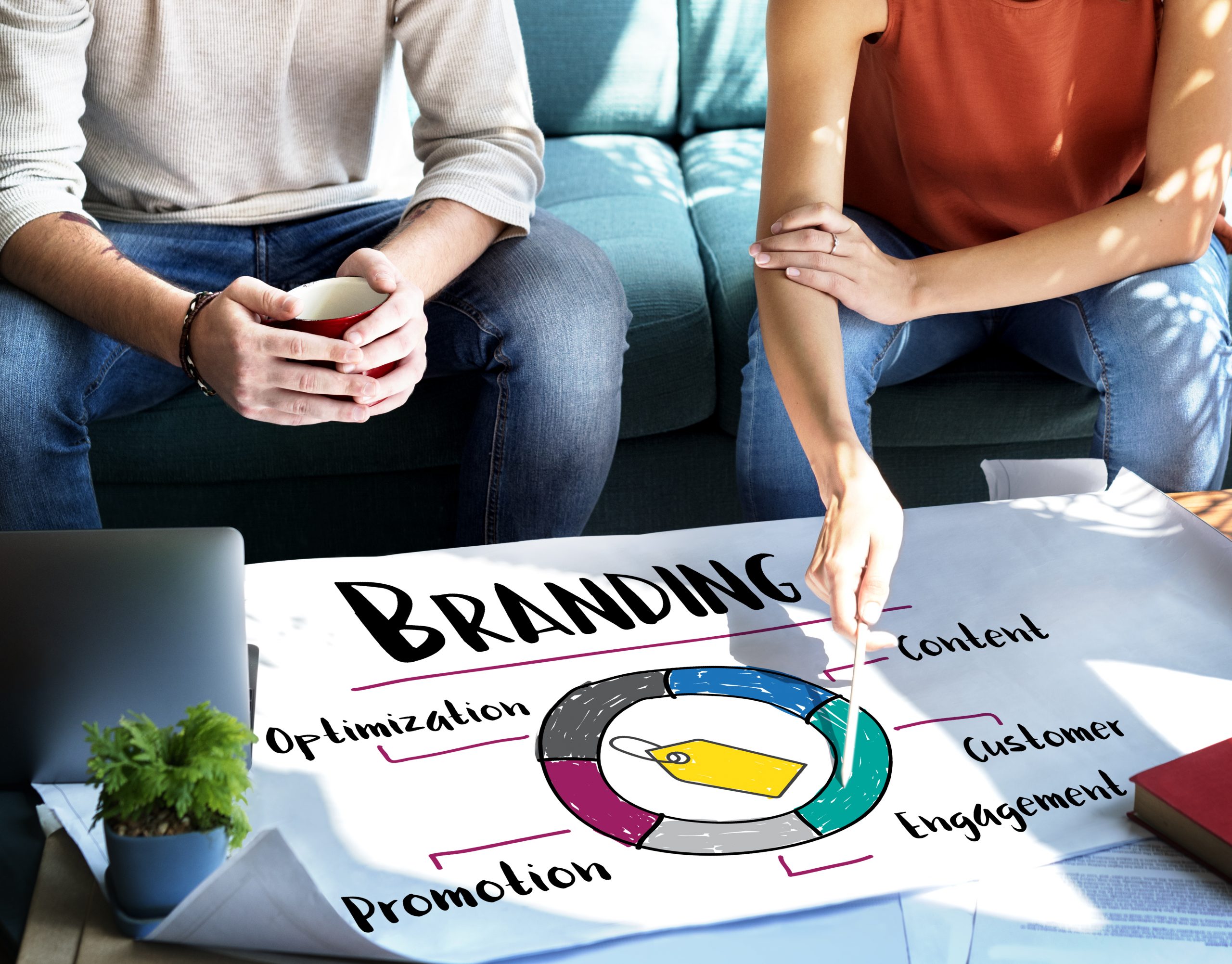
What Is Branding? Why Is It so Important for Business?
So, basically, what is branding? According to Entrepreneur magazine, branding is the marketing practice of creating a name, symbol (such as a logo) or design that identifies and differentiates a product from other products and makes a company memorable. In 2020, branding also includes communication strategies and a company’s presence on the Internet. Branding strategies are aimed at raising brand awareness and selling as many products as possible. Branding’s target is to make the business appealing to potential employees and clients. As usual, identity branding starts with market research which includes a competitive market study and analyzing the product’s target audience (needs, fears, and tastes) which results in a brand mission and positioning. Then comes the visual part. Finding your brand style is the first step in branding and the second one is to create a visual identity for your brand which includes corporate colors, shapes, advertising templates, logos, and many other elements. Just as with the tone of voice for the cpy (which should appeal to the target audience and be clear for it), visual language is the basis of branding (the task is to generate stable visual association for the customers with a company and its products).Approaches to Brand Strategies
There are at least 4 major approaches to building strategies for branding in 2020. Each of them is based on a special type of emotional connection between your company and its clients:-
- Integrate a brand into the everyday life of customers. Make sure you direct customers to your website as soon as they start searching for your brand.
- Turn a brand into a trusted companion that provides clients with something extremely useful
- Make the brand unique and appealing for the audience and make them associate this brand with something trending, exclusive and desirable
- Associate the brand with some cool people who use it and make it appealing because of a client’s desire to be as cool as others
Top Visual Trends of Branding Creation in 2020—2021
#1 Environmentally-friendly branding
Sustainable living is not just a trend but a necessity for a modern person. And values connected to the going green lifestyle and production are now something that unites billions of your potential customers. You can incorporate environmental values into your logo or website design temporarily (like Evian water did) to draw attention to a current environmental issue that customers can help to resolve. If you’re just developing a corporate identity and environmental protection is not your core brand value, consider how you can reinforce your brand’s association with something natural and clear (for example, with earthy corporate tones). While designing packaging and other physical items, you should follow environmental values. They should be recyclable, and their production should leave as little of an environmental footprint as possible. It deserves special attention#2 Authenticity with visual communication
Social media has transformed the requirements for brands in 2020. Today, product makers and service providers must compete for user attention not only with other businesses, but also with the vast array of macro- and micro-influencers that Facebook, Instagram, and TikTok are crowded with. In other words, it will be difficult for a brand to build long-term relationships with customers and evoke positive associations in them if it does not start playing by the rules of social media. What rules are we talking about? First of all, it is authenticity, honesty, bold emotions, and openness. Minimalistic logos and simple fonts, translucent packaging, peer-to-peer communication via messengers, and showcasing the life of your team are some examples of how a designer can make a brand look kind, friendly, and trustworthy. Moreover, the persona of the client should come to the fore. Show your satisfied customers, not your shiny products! Or at least make your clients happy even with your ad. An excellent example of such an approach is Bill Murray’s ads for Jeep in 2020.#3 Whatever-you-like typography and images
A few years ago, visual branding had a boom with anti-aesthetics, and today the trend has reached typography. Ugly beauty and anti-design were in demand because many buyers now have smartphones with cameras and processors that allow them to create perfect pictures in a few seconds. As a result, some show business stars threw away professional equipment and released clips filmed on a smartphone, and fashion houses refused to retouch models’ faces before seasonal campaigns. In 2020, the aesthetic of the ugly was replaced by the authenticity of the visual branding, that is, how a brand manages to visually embody its difference from competitors. In other words, images can be anything you want. The main thing is that they reflect brand values and be in the same recognizable style. When it comes to font decisions, in 2020, artistic and free-spirited fonts have become another tool for the brand manifesto and another place where you can break the norm. Check out 3D Typography by Alexis Persani or World Rally Championship typo guidelines.
#4 Adaptive branding creation
Today, more and more Internet users are using mobile devices to communicate, search for goods and services, and shop. At the same time, the sizes and proportions of screens of modern devices are very diverse. This puts new standards on visual branding. Now the design elements (including logos), should be responsive. The same rule applies to illustrations on the website and images for social networks. The goal of adaptive design is to provide users with the best possible visual experience and even create an additional aesthetical value of anything visual users might come across while searching for products. Shape-shifting logo designs are just the most striking expression of modern responsive design. In 2020, we recommend that you create full-fledged brand books that would contain many variations of logo designs and other elements of the corporate identity.#5 Imitating the real world
Regardless of what kind of entrepreneurial activity you are planning to engage in, you need to consider that in a modern world (especially after the COVID-19 pandemic) people are more online than offline. This means that your brand identity should be designed to represent your company and its products on the Internet. At the same time, in 2020, more and more companies are moving online (especially in retail, legal aid, and medical services), which increases competition for the attention and trust of users of the global network. How can you build an emotional connection with a potential buyer if you do not have the opportunity to contact them offline? A brand manager’s response in 2020 and 2021: fake offline communication and imitate a brand’s physical presence in the customer’s world by conducting immersive campaigns. Branding that exploits images of the client’s real (rather than virtual) world will be more successful in the coming years. In particular, we are talking about the use of skeuomorphism design, which is based on simulating textures such as leather, metal, wood, cardboard, and so on. In addition, you can invest in an immersive branding approach and work on audio branding and phigital marketing campaigns.#6 Dreams-based identity branding
Globalization has done its job: our news feed is filled with dramatic news from around the world. On the one hand, this kind of freedom of information means that our world has become more democratic. On the other hand, your potential clients now have additional sources of stress. A playful and slightly naive branding that generates a sense of relief in the user’s mind is something that can help you connect with your audience. Coloring books style brand identity is a recent visual trend that may well stay with us for a long time. In addition to the naive graphic style and dreamy illustrations, they also help brands associate in the customer world with relief, reliability, happiness, and simple everyday pleasures. You can also use collages and authentic stock photos to enhance your brand image. Just remember, you don’t have to sound too serious. The world has already become a tough place. So why not offer your customers an alternative? Discover some recent branding creation cases by Kokoromoi (Finland) and Urban Goodies for inspiration.#7 Minimalism meets Baroque
Minimalism has been a visual branding trend of the last decade, but in recent years, there has been a demand on the market for authenticity in visual communication. The main rule that companies need to adhere to in 2020 and 2021 is striking a reasonable balance between restraint in typography and style of images and originality, which could help a brand to look different from competitors. And here comes Baroque to help us. On the one hand, we have blandified branding, which means that fonts should always be readable and images should be understandable. On the other hand, a brand manager’s job is not to make the brand boring. The neo-Baroque style is not only about gold, glitter, unexpected animation, and visual complexity for the sake of complexity. It is the ability to nuance a blandified branding identity with self-contained decorative elements that grab attention. A great example of creating fresh and luscious branding at the intersection of minimalism and identity is Balenciaga, Uniqlo, and the 59th Thessaloniki International Film Festival.#8 Telling nostalgic stories through branding elements
As you know, branding includes all elements of corporate visual identity, as well as the style of verbal communication and the logic of customer services. If all of these elements are integrated into a coherent narrative, your company has a better chance of being remembered by potential customers. To design a brand narrative, you need to analyze your customer journey. Answer the questions about what the first touchpoint between you and your client is, what this person sees when they decide to opt for your product, what tools they use to communicate with you, and what happens after you have closed the deal. Your branding, from your logo to product packaging and sales receipt design, can be turned into a story. This year, the trend for nostalgic allusions is still strong. Millennials, who today are the most massive audience for the market, recall with pleasure their childhood without the Internet and youth at the dawn of Internet communication. Add to that references to famous movies and music of that time, and the perfect story-building set is ready!#9 Rely on technology while creating brands
In 2020, it would be strange for brand managers to ignore the technological process. Of course, you can limit yourself to visual displays of branding and use modern technology (such as voice assistants, chatbots, and AI-based product catalogs that adapt to the tastes of specific users) only as an auxiliary tool. But we have a better idea! Create a technology-based brand strategy. Try to identify what modern technology (including those that might be developed for your company) set you apart from the competition. For instance, if you’re selling books, your branding might be about using technology to help people read more. To do this, you can offer a machine learning-powered selection of books for customers, an application for keeping a reader’s diary, and much more. Take Nike as an example. It has enhanced its image as a sports empowerment company by creating workout apps for amateur sportsmen. Here are just a couple of examples of technology that may be useful for you: speech recognition, face detection, VR and AR, shopping beacons, 360-degree video, geo-tracking, and health monitoring.
Practical Tips on Creating Branding: Step-by-Step Guide
As Seth Godin, an American author and former dot com business executive defined that a brand is nothing but a set of expectations, memories, stories, and relationships. All this makes consumers choose one product over another. And we cannot argue with this. But when the task sounds so ambitious, it is difficult to decide where to start with branding for business. Here are a few tips and tricks from Depositphotos marketers to make your creative search easier.Step 1. Define your brand
The first step is to determine how your product or service will benefit your audience. Let’s say you want to open a local cleaning service. In this case, the benefit that you bring to the consumer is the cleanliness in their house, which they receive without physical effort on their part and can do so quickly. Your decision about how you benefit the client also determines what your company’s values are and what your strategy is. In the case of a cleaning company, this can be the quality of cleaning and the comfort of your client. For example, you quickly take orders, communicate politely with clients, provide several payment options for services, etc. Perhaps your corporate value is also reliable. That is, a client can turn to you in difficult situations and be sure that you will cope even with a very difficult task. Results: your business description and the list of corporate valuesStep 2. Imagine your ideal customer
Understanding who your customer is remains the key condition for your brand’s success. Knowing how you benefit your customers, determine for which of them resolving such issues is really very important. Then, describe your client using categories such as gender, age, nationality, profession, marital status, annual income, and others. Find out what your target customer is afraid of and what they love, what aesthetics they prefer, and who influences this person’s decisions. You can even go further and analyze your target client’s childhood passions. The more you know about your audience, the easier it will be for you to build a strong brand. Therefore, it will be easier to plan your next marketing campaign. Results: precise target audience descriptionStep 3. Work on emotional connections
Remember that branding is not only about letting people know that your product will benefit them in a certain way. It is also about the emotional connection between your product, your company, and your customer. At this stage, you have in your hands a list of the benefits that your product brings to a potential buyer. And you should also create a portrait of this buyer. Now, you might be wondering what emotions this customer should feel about your brand and products at different stages of your communication. For example, the same cleaning service can be sold exploiting different emotions of the customers. The company can use the client’s fear like “Friends will visit me and see how sloppy I am” and evoke feelings of calmness and gratitude as a cleaning company accepts the order. A cleaning company can also exploit consumers’ vanity by promising people that their home will be as clean as a British Queen’s castle, as your company uses the same equipment and household chemicals. Results: a well-thought-out concept of emotional connections between your product and its target audience
Step 4. Finding touchpoints and using your branding tools
To move on to creating visual branding, you need to clarify what elements it can contain. If you work in eCommerce, developing your brand involves creating website page designs and online advertising templates. And you don’t have to design physical points of sale. How can you create a list of your branding tools? Analyze your customer journey and list your touchpoints, then describe what visuals consumers will interact with. This approach will help you determine what the real leverage is with your target audience. Results: the list of materials, objects, and places that require brandingStep 5. Create several brand concepts. Choose the best one!
At this stage, you will need not only a brand manager, a marketer, and other team members to discuss business values. Don’t forget about hiring a designer. Their task is to create a visual brand image. They take into account all the facts about your target audience, the value of the company and the product, as well as the specific points of interaction between your business and its audience. The more concepts the designer (or design team) generates, the better. You can use a focus group to select the most promising brand concept. Results: ready-to-use brand book
Step 6. Improve your branding
Are you familiar with the Lean Startup concept? Although the term comes from the IT business, the ideas behind it can be applied to branding. In short, we are talking about a Learn-Build-Measure cycle that can be repeated indefinitely. We recommend holding regular team meetings. You will be able to analyze how you can improve your brand, what you lack in it, and whether it is worth rethinking your brand idea. Leverage feedback from real customers and partners as well as from marketing results. In the case of branding a local cleaning service. A month after using the brand book, you may come to the conclusion that when creating your brand, you ignored the staff form. At the same time, your employees are the only people with whom customers interact offline. Thus, they determine the customer’s impression of your service. It is a good idea to fill this gap. Results: branding improvementsConclusion
Although branding doesn’t seem like an easy task. In this article, we have tried to explain the key steps in this procedure. We’ve highlighted the top visual branding and marketing trends for 2020 and 2021. To wrap it up, it’s important to emphasize that creating branding includes much more than just creating its visual elements. There is no such thing as good and bad branding for businesses. The quality of your branding is determined by whether the company manages to build an emotional connection with the target audience. It is crucial whether your potential buyer recognizes your brand among hundreds of competitors, and whether you have gained the trust of your clients. To achieve these and many other results, you need to carry out preparatory work.- Define the mission, branding concept and idea, and the values of your company. Study the target audience and your competitors. Decide what emotions and things you want to associate with in the world of your customers.
- Move on to visual strategies for branding. Brand elements include the name of the company and its logo, visual identity and communication style, etc. Apply to those points that the company uses to convey corporate ideas, company values, and goals. All these things must be described in the brand book. It is important to understand that they are all connected.









